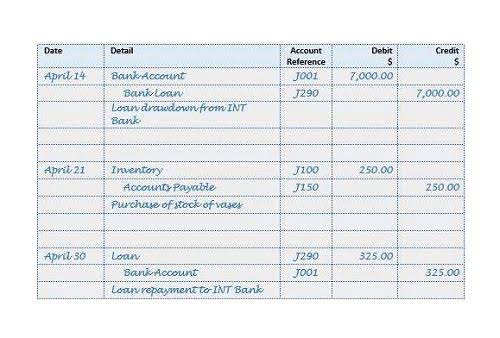
T-Account: Definition, Example, Recording, and Benefits

This initial transaction demonstrates that the corporation has established a liability to pay the expense and an expense. No matter the account, the debit side is always on the left, and the credit side is always on the right. The left side of the Account is always the debit side and the right side is always the credit side, no matter what the account is.

Mary Girsch-Bock is the expert on accounting software and payroll software for The Ascent. However, T-accounts are useful for understanding the effects of difficult transactions so as to avoid making any mistakes. T-accounts are not used on a regular basis due to the use of accounting t accounts software. T-accounts are an account structure that shows the effect of journals entries on accounts. The standard T-account structure starts with the heading including the account name. The left column is always the debit column while the right column is always the credit column.
What Are T Accounts and Why Do You Need Them?
Thus, T accounts are only a teaching and account visualization aid. The T account is a fundamental training tool in double entry accounting, showing how one side of an accounting transaction is reflected in another account. This approach is not used in single entry accounting, where only one account is impacted by each transaction. T accounts are also used by even experienced accountants to clarify the more complex transactions.

The grand total balance for each “T” account appears at the bottom of the account. A number of T accounts are typically clustered together to show all of the accounts affected by an accounting transaction. Using T Accounts, tracking multiple journal entries within a certain period of time becomes much easier. Every journal entry is posted to its respective T Account, on the correct side, by the correct amount.
How the last housing market crash helped create today’s conditions
That makes T accounts a good place to start when thinking about bookkeeping and accounting, but also financial management. We’ve been developing and improving our software for over 20 years! Thousands of people have transformed the way they plan their business through our ground-breaking financial forecasting software. It really shows how useful it is to try to draw out transactions in T-accounts before they are committed to the company records.
Allowance for Doubtful Accounts: Methods of Accounting for – Investopedia
Allowance for Doubtful Accounts: Methods of Accounting for.
Posted: Tue, 29 Aug 2023 07:00:00 GMT [source]
If you’re looking to get started in business accounts, one of the best ways to do so is by using a T Account template. This allows you to track your accounts’ activity, giving you a more detailed understanding of your financial standing. And best of all, there are plenty of we have an Excel template and PDF available for free download. Whenever cash is received, the Cash account is debited (and another account is credited). Debits to revenue and gain can reduce the account balance, while credits increase it. In the company’s books, these transactions are documented as journal entries.
Cost of Goods Sold [Basics: Explained & Made Easy]
The double-entry system helps prevent errors, while the T accounts can be logically ordered to make it easy to find specific transactions quickly. In January, I pay £6000 in cash to the landlord, so my bank (asset) account is credited £6000. In this section, I’m going to go through different types of transactions, and I’ll be using T-accounts to display the movement of value through the business. I will use my coffee shop to represent a business throughout these examples. The left-hand side is where you enter debits whilst the right-hand side is where you enter credits.
T-accounts are a colloquial word for a set of financial records that use double-entry accounting. It’s termed because the bookkeeping entries are arranged in the shape of a T. It would be considered best practice for an accounting department of any business (that is not using a single entry method of accounting) to employ a T account structure in their general ledger. Below is a short video that will help explain how T Accounts are used to keep track of revenues and expenses on the income statement. If an account owner fails to withdraw the full amount of the RMD by the due date, the owner is subject to an excise tax equal to 25% of the amount not withdrawn for 2023 and later years. The SECURE 2.0 Act dropped the excise tax rate from 50% for distributions required for 2023 and reduces the tax rate to 10% if the error is corrected within two years.
T Accounts Guide
A T-account is used to track specific transactions, while the balance sheet is a summary of a company’s overall financial position. Both statements are important tools in accounting and finance, and they are used to help stakeholders understand a company’s financial health. It makes it a valuable tool for any student pursuing a career in accounting, as it allows for a more in-depth understanding of an organisation’s financial standing. T-accounts can also be used to record changes to the income statement, where accounts can be set up for revenues (profits) and expenses (losses) of a firm. For the revenue accounts, debit entries decrease the account, while a credit record increases the account.
- The credit was to loan, so this is used to describe what has happened to our bank account above.
- If the labor costs are still debited and credited fully, then this type of mistake can also be difficult to catch.
- This allows you to track your accounts’ activity, giving you a more detailed understanding of your financial standing.
- T-accounts are typically used by bookkeepers and accountants when trying to determine the proper journal entries to make.
If your business is paying money out, then you would subtract to the credit side. This is all going to help when looking at a T account if you remember the phrase dealer. Put your dividends, expenses and assets on the left of the T account to increase them. Liabilities, Owner’s Equity and Revenue go on the right to increase them. A T-account is a visual depiction of what a general ledger account looks like. It also makes it quite easy to keep track of all the additions or deductions in an account.
